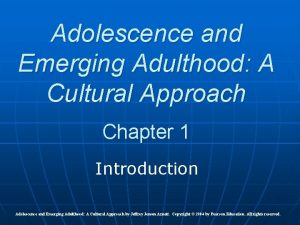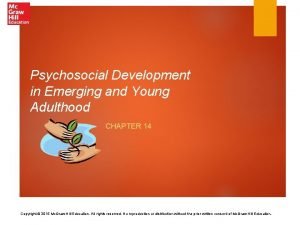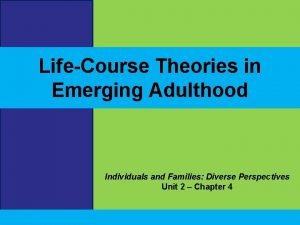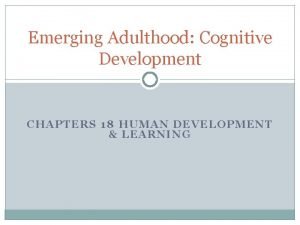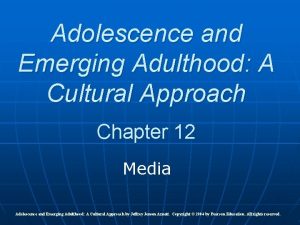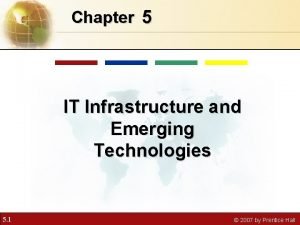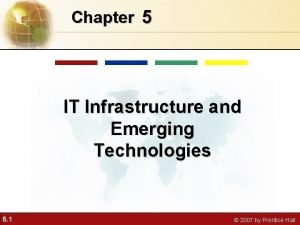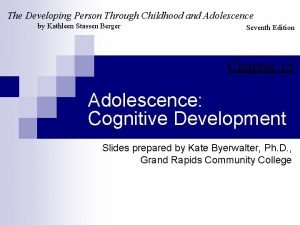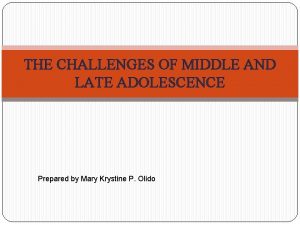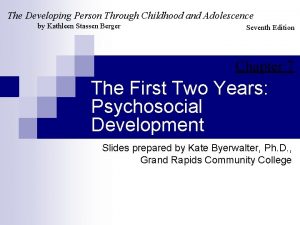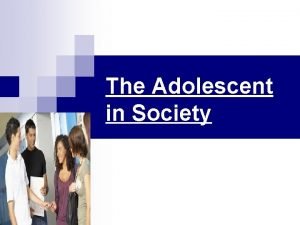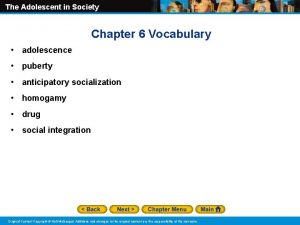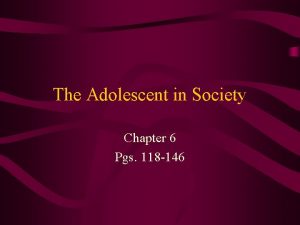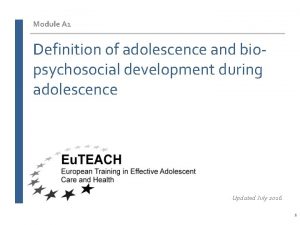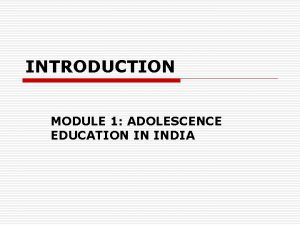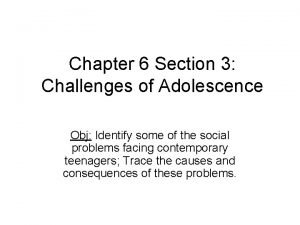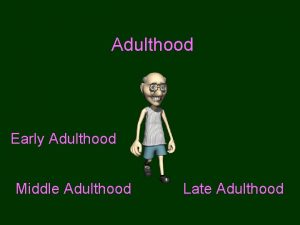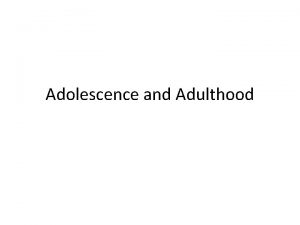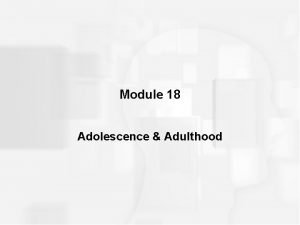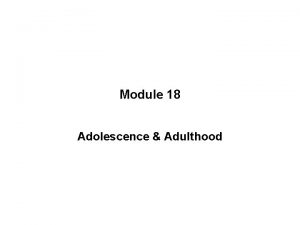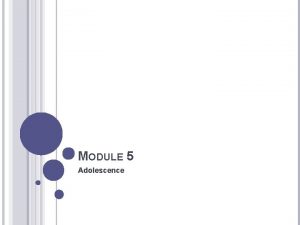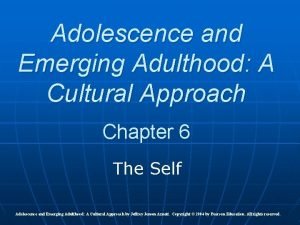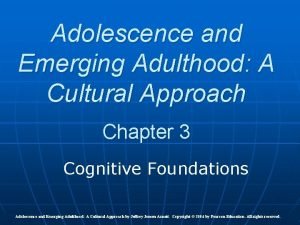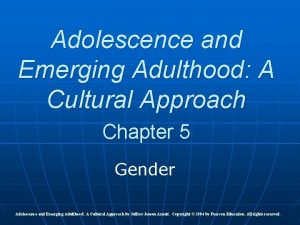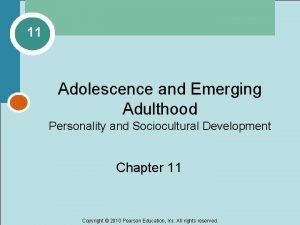Chapter 12 Culture CULTURE ADOLESCENCE AND EMERGING ADULTHOOD


































- Slides: 34

Chapter 12 Culture

CULTURE, ADOLESCENCE, AND EMERGING ADULTHOOD • What Is Culture? – Culture is the behavior, patterns, beliefs, and all other products of a particular group of people that are passed on from generation to generation. – Culture is a broad concept—it includes many components and can be analyzed in many ways (Cole, 2006).

CULTURE, ADOLESCENCE, AND EMERGING ADULTHOOD 429 • What Is Culture? – Culture is made up of ideals, values, and assumptions about life that guide people’s behaviors. – Culture is made by people. – Culture is transmitted from generation to generation, with the responsibility for transmission resting on the shoulders of parents, teachers, and community leaders.

What was the culture of your school? • Talking points: Student at Noe • Alt Cert Teachers: Fairdale and Bullitt Central

School Culture Vision: Is a statement that directs the system towards what it aspires to become. It is future-focused. Mission: Is a statement that defines the purpose of the existence of the system; it defines why it exists Beliefs: Are shared convictions and related actions that staff want to live by internally and as seen by others external to the system. They are operating principles. Values: Defines the personal attributes that are regarded as essential to model and promote by all employees of the system.

CULTURE, ADOLESCENCE, AND EMERGING ADULTHOOD • What Is Culture? – Culture’s influence often becomes noticed the most in wellmeaning clashes between people from very different cultural backgrounds. – Despite compromises, cultural values endure. – When their cultural values are violated or when their cultural expectations are ignored, people react emotionally. – It is not unusual for people to accept a cultural value at one point in their lives and reject it at another point. For example, rebellious individuals might accept a culture’s values and expectations after having children of their own.

CULTURE, ADOLESCENCE, AND EMERGING ADULTHOOD • Two additional important dimensions of culture in adolescents’ and emerging adults’ lives are socioeconomic status and ethnicity: – Socioeconomic status (SES) refers to a grouping of people with similar occupational, educational, and economic characteristics. – Ethnicity is based on cultural heritage, nationality characteristics, race, religion, and language.

CULTURE, ADOLESCENCE, AND EMERGING ADULTHOOD • The Relevance of Culture – Schools and neighborhoods are no longer the fortresses of a privileged group whose agenda is the exclusion of those with a different skin color or different customs. – Immigrants, refugees, and ethnic minority individuals increasingly decline to become part of a homogeneous melting pot, instead requesting that schools, employers, and governments honor many of their cultural customs. – Noe as compared to Bullitt Central

CULTURE, ADOLESCENCE, AND EMERGING ADULTHOOD • The Relevance of Culture – In the twentieth century, the study of adolescents and emerging adults was primarily ethnocentric, emphasizing American values, especially middle-SES, White, male values (Spencer, 2000). • One example: – Ethnocentrism—the tendency to favor one’s own group over other groups—is the American emphasis on the individual or self.

CULTURE, ADOLESCENCE, AND EMERGING ADULTHOOD • The Relevance of Culture – People in all cultures have a tendency to (Brewer & Campbell, 1976) • Believe that what happens in their culture is “natural” and “correct” and that what happens in other cultures is “unnatural” and “incorrect. ” • Perceive their cultural customs as universally valid; that is, what is good for us is good for everyone. • Examples?

CULTURE, ADOLESCENCE, AND EMERGING ADULTHOOD • The Relevance of Culture – People in all cultures have a tendency to (Brewer & Campbell, 1976) (Continued) • Behave in ways that favor their cultural group. • Feel proud of their cultural group. • Feel hostile toward other cultural groups. – Over the past few centuries and at an increasing rate in recent decades, technological advances in transportation, communication, and commerce have made these ways of thinking obsolete.

CULTURE, ADOLESCENCE, AND EMERGING ADULTHOOD • Cross-Cultural Comparisons – Cross-cultural studies involve the comparison of a culture with one or more other cultures, which provides information about the degree to which the development of adolescents and emerging adults is similar, or universal, across cultures, or the degree to which it is culture-specific (Shiraev & Levy, 2007).

CULTURE, ADOLESCENCE, AND EMERGING ADULTHOOD Average Daily Time Use of Adolescents in Different Regions of the World Fig. 12. 1

CULTURE, ADOLESCENCE, AND EMERGING ADULTHOOD • Achievement – US adolescents are: • More achievement oriented than the adolescents in many other countries • Less so than East Asians • Sexuality (Read aloud page 433) – Culture also plays a prominent role in adolescent and emerging adult sexuality (Saraswathi, 2006). • Some cultures consider adolescent sexual activity normal; others forbid it.

CULTURE, ADOLESCENCE, AND EMERGING ADULTHOOD Points of Interest (435) • Rites of Passage – Ceremonies or rituals that mark an individual’s transition from one status to another, such as the entry into adulthood. – Some societies have elaborate rites of passage that signal the adolescent’s transition to adulthood; others do not. – The absence of clear-cut rites of passage makes the attainment of adult status so ambiguous that many individuals are unsure whether they have reached it or not. – What are our rites of passage?

SOCIOECONOMIC STATUS AND POVERTY • What Is Socioeconomic Status? – The grouping of people with similar occupational, educational, and economic characteristics. Socioeconomic status carries with it certain inequalities: • Occupation • Education • Economic Resources • Power to Influence

SOCIOECONOMIC STATUS AND POVERTY 437 • Socioeconomic Variations in Families, Neighborhoods, and Schools – Parenting Style – Intellectual Experiences – Mental Health – Negative Experiences

SES • Lower SES Parents – More concerned what their children conform to societies expectations – Create home atmosphere in which it is clear that parents have authority – Use physical punishment more – More directive and less conversational with children

SES • Higher SES Parents – Concerned with developing children's initiative and delaying gratification – Home atmosphere in which children are more nearly equal participants and rules are discussed as opposed to being laid down – Less likely to use physical punishment – Less directive and more conversational

SES 437 • Low SES children – Risk for low achievement – Emotional problems – Lower occupational attainment – Social maladaptation – Psychological problems – Low self confidence – Peer conflict – Juvenile delinquency

SES • When low-SES kids are doing well in school, it is often because – A parent or parents are making special sacrifices to provide the necessary living conditions and support to contribute to school success. – Have high educational aspirations for child

SOCIOECONOMIC STATUS AND POVERTY • Poverty – Some adolescents are resilient and cope with the challenges of poverty without major setbacks, but many struggle unsuccessfully. – In 2005, 17. 8 percent of children under 18 years of age were living in families below the poverty line (U. S. Bureau of the Census, 2006). – The U. S. figure of 17. 8 percent of children living in poverty is much higher than those from other industrialized nations. – Canada= 9% – Sweden= 2%

Poverty • Poverty in the US is demarcated along ethnic lines: – Almost 50% of African American and – 40% of Latino children live in poverty!

Ramifications of living in poverty • Living in poverty has many psychological effects on adolescents and adults. • The poor are powerless (they are rarely the decision makers) • They are often vulnerable to disaster. • Their range of alternatives is often restricted. • Because of inadequate education and inability to read well, being poor means having less prestige.

Ramifications of living in poverty • Experience more conflict, violence, instability and chaos in their homes. • They get less social support, and their parents are less responsive and more authoritative. • They watch more TV and have less access to books and computers. • Their schools and child-care facilities are inferior, and parents monitor their school activities less. • The air they breathe and the water they drink are more polluted, and their home are more crowed and noisy. • They live in more dangerous and physically deteriorating neighborhoods with less adequate municipal service.

SOCIOECONOMIC STATUS AND POVERTY • Feminization of poverty – Far more women than men live in poverty. – Likely causes include: • Lower income for women • Divorce • Resolution of divorce cases by the judicial system – leaves women with less money than needed to function adequately

THE MEDIA AND TECHNOLOGY Of all the newly developed technologies available, the most time was spent watching TV Fig. 12. 4

THE MEDIA AND TECHNOLOGY Older adolescents spend more time listening to music and using the computer Fig. 12. 5

THE MEDIA AND TECHNOLOGY • Television and Violence • Correlation research • Indicates that watching television violence is associated with aggressive behavior. • Experimental research • Provides evidence that viewing television violence can increase aggression.

THE MEDIA AND TECHNOLOGY • Television and Violence • The television that young children watch may influence their behavior as adolescents. • There is increased concern about children and adolescents who play violent video games, especially those that are highly realistic. • Television and Sex • The number of sexual scenes on TV nearly doubled from 1998 through 2004 (Kaiser Family Foundation, 2005).

THE MEDIA AND TECHNOLOGY (Continued from previous slide) • Television and Sex • The number of sexual scenes on TV nearly doubled from 1998 through 2004 (Kaiser Family Foundation, 2005). • Watching television sex can influence adolescents’ sexual attitudes and behavior. • Television teaches children and adolescents about sex (Brown, Halpern, & L’Engle, 2005). • The overall conclusion about adolescent exposure to sex in the entertainment media is very negative (Collins, 2005).

THE MEDIA AND TECHNOLOGY • Television and Achievement • The more adolescents watch TV the lower their school achievement is (Comstock & Scharrer, 2006; Shin, 2004). • Three possibilities involve interference, displacement, and self-defeating tastes/preferences (Comstock & Scharrer, 2006). • Interference • Having a television on while doing homework can take away time and attention from engaging in achievement-related tasks, such as homework, reading, writing, and mathematics.

THE MEDIA AND TECHNOLOGY (Continued from previous slide) • Television and Achievement • Displacement • Reading achievement is negatively linked with the amount of time they watch TV (Comstock & Scharrer, 2006). • Self-defeating tastes/preferences • Television attracts adolescents to entertainment, sports, commercials, and other activities that capture their interest more than school achievement. • Adolescents who are heavy TV watchers tend to view books as dull and boring (Comstock & Scharrer, 2006).

THE MEDIA AND TECHNOLOGY (Continued from previous slide) • Television and Achievement • Some types of television content—such as educational programming for young children—may enhance achievement. • Such as Sesame Street and Mr. Rogers’ Neighborhood
 Jeffrey arnett emerging adulthood theory
Jeffrey arnett emerging adulthood theory Infancy childhood adolescence adulthood old age
Infancy childhood adolescence adulthood old age Emerging adulthood psychosocial development
Emerging adulthood psychosocial development Jeffrey arnett emerging adulthood theory
Jeffrey arnett emerging adulthood theory Cognitive development in emerging adulthood
Cognitive development in emerging adulthood Jeffrey arnett emerging adulthood theory
Jeffrey arnett emerging adulthood theory Chapter 4 adolescence psychology
Chapter 4 adolescence psychology Chapter 4 adolescence psychology
Chapter 4 adolescence psychology The byzantine empire and emerging europe answer key
The byzantine empire and emerging europe answer key Emerging technology chapter 5
Emerging technology chapter 5 It infrastructure and emerging technologies
It infrastructure and emerging technologies It infrastructure and emerging technologies
It infrastructure and emerging technologies Contcloud
Contcloud Emerging technology chapter 5
Emerging technology chapter 5 Emerging technology chapter 4
Emerging technology chapter 4 Chapter 22 life in the emerging urban society
Chapter 22 life in the emerging urban society Adolescent egocentrism
Adolescent egocentrism Fast mapping
Fast mapping Challenges middle and late adolescence
Challenges middle and late adolescence Eating a balanced diet during childhood and adolescence
Eating a balanced diet during childhood and adolescence The developing person through childhood and adolescence
The developing person through childhood and adolescence Principles of growth and development
Principles of growth and development Developing person through childhood
Developing person through childhood Dating serves several important functions that include:
Dating serves several important functions that include: Adolescence vocabulary
Adolescence vocabulary Chapter 6 the adolescent in society
Chapter 6 the adolescent in society Adolescence
Adolescence Brain development adolescence
Brain development adolescence Dominant value direction
Dominant value direction Moral development in adolescence
Moral development in adolescence Late adolescence
Late adolescence Objectives of adolescence education
Objectives of adolescence education Erikson's 7th stage
Erikson's 7th stage Meaning of adolescence stage
Meaning of adolescence stage Suicide cuts across all social categories
Suicide cuts across all social categories
